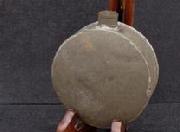 |
| Small Tin Drum Militia Canteen - All Soldered |
|
|
Here is a Fine Pre-War or Civil War Period Tin Drum Militia Canteen ! It still has the tin spout, all three sling loops, and a single wide tin belt loop present, all in good order. The canteen shows all soldered construction, with one side flat and the other convex. Typical in size of many mid-1800s militia canteens, the body of the canteen measures 4.5 inches diameter by 1.5 inches wide, with the tin spout being just a tiny bit over half an inch tall. The very wide belt loop on the reverse would accept up to about a 3.25 inch belt. I see no holes or rusted thru areas, and all the tin wears a very nice old gray patina. Just a Fine Civil War Period Tin Drum Militia Canteen ! [ L.L. ]
$295 REDUCED $150 plus shipping
|
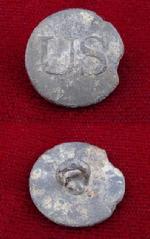 |
| Fine Displaying Dug U.S. “War of 1812” Infantry Coat Button |
|
|
Here is a Fine Displaying Dug U.S. “War of 1812” Infantry Coat Button ! This pattern was used from 1808-1830, and this one displays the U.S. Letters very well. There are two very small chips out of one side, but the reverse shows shank still intact. Approximately 19mm. Recovered near Sackett’s Harbor, New York. A Fine Early U.S. Infantry Coat Button with a Sharp U.S.!
$45 plus shipping
|
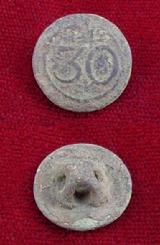 |
| Fine Displaying Dug Revolutionary War French, 30th Regiment of Infantry Button |
|
| Here is a Fine Displaying Dug Revolutionary War French, 30th Regiment of Infantry Button ! Made of copper or brass, the front still shows fairly good detail, with the number 30 at center surrounded by a circle with flourishes at the top. The reverse shows a turret type attachment also still in good shape. The button measures approximately 17mm. This regiment came to Philadelphia with the French Army in 1781, to assist George Washington against Cornwallis at Yorktown. Recovery location unknown but here in the United States as it was in a case with other Revolutionary War buttons recovered at known sites here. A Fine Displaying Revolutionary War Button worn by French Forces assisting the Continental Army !
$145 plus shipping
|
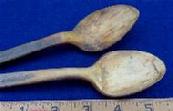 |
| Nice Pair of Rev War/Colonial Period Horn Spoons |
|
| Here is a Very Nice Pair of Colonial Period Horn Spoons ! Each one measures about 7 inches long, with a bowl that is about 1.5 inches across. Both are in good condition, and look as if they could be used today. There are similar examples in the book, Collector’s Illustrated Encyclopedia of The American Revolution, by Neumann & Kravic, on page 108. A Fine Displaying Pair of Colonial Period Horn Spoons !
SOLD
|
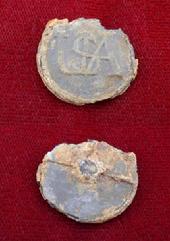 |
| Dug U.S. Continental Army Soldier’s Revolutionary War Coat Button |
|
|
Here is a Dug U.S. Continental Army Soldier’s Revolutionary War Coat Button ! It shows some metal loss, especially at the top, and around the edges, but the entwined “USA” is still very visible. The reverse shows the attachment shank missing, and a prominent mold seam. This is a large coat size button, measuring approximately 24mm currently, though it may have been a bit larger originally. Recovery location unknown. A Nice Displaying Entwined USA Coat Button once worn by a Soldier in George Washington’s Continental Army !
SOLD
|
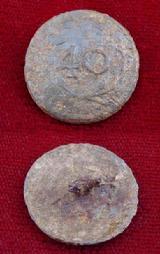 |
| Fine Dug British 40th Regiment of Foot, Revolutionary War Coat Button |
|
|
Here is a Fine Dug British 40th Regiment of Foot, Revolutionary War Coat Button ! The British 40th Regiment was sent to Boston in 1775, and later participated in engagements in New York, Princeton, Philadelphia, Brandywine, Paoli, Germantown, and several others. This pewter button shows the number 40 at center surrounded by a wreath with a patterned edge, and though having modest ground action, the front still displays well. The reverse shows additional ground action and the iron shank partially intact. The button measures approximately 22mm. Recovered in Mt. Independence, Vermont. A Fine Displaying Revolutionary War British Regimental Button !
SOLD
|
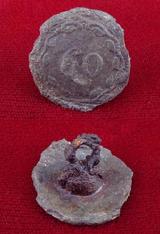 |
| Good Displaying Dug Revolutionary War, British 60th Regiment of Foot, aka. 6Oth Royal Americans, Coat Button |
|
|
Here is a Good Displaying Dug Revolutionary War, British 60th Regiment of Foot, aka. 6Oth Royal Americans, Coat Button ! During the American Revolution portions of the Regiment served in the Southern Campaigns, including engagements at Brown’s Creek, Hulson Ford, Fort Morris, and the Siege of Savannah, among others. The pewter button shows ground action with portions of the edge deteriorating, but the number 60 at center and the wreath around it are still fairly visible. The reverse shows the edge damage more than the front, and an intact iron shank. Recovery location unknown. A Nice Displaying British Regimental Button from the American Revolution !
SOLD
|
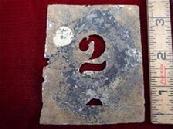 |
| Excellent Displaying Dug Revolutionary War, to War of 1812, Pewter or White Metal Stencil for the Number 2 |
|
| Here is an Excellent Displaying Dug Revolutionary War, to War of 1812, Pewter or White Metal Stencil for the Number 2 ! The stencil is still in good shape to have been excavated, with a little bit of loss at the left edge, and a crease with a partial break near the bottom. It is still 95% intact though and displays its Script Number 2 Perfectly. It measures about 2.75 inches wide by 3.5 inches tall, and was recovered near Fort Powhatan, Virginia. Originally built in 1779, during the American Revolution, Fort Powhatan, was added to, and used off and on until abandoned at the end of the American Civil War. A Fine Displaying and Unusual White Metal Stencil likely near 200 years old & Recovered near an Important Historic Site !
SOLD
|
|